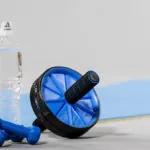The plank isn’t just a core exercise. It’s a baseline test of how well you can stabilize your entire body. Do it right, and it builds strength that transfers to everything – lifting, running, posture… Do it wrong, and you’re just wasting time. So let’s see how planks for beginners should be done.
What Planks Are Actually For
Planks are about stability, not endurance. The goal isn’t to hold a position for five minutes straight. It’s to create full-body tension while keeping your spine locked in place.
You’re training your core to resist movement. That means no twisting, sagging, or shifting. A proper plank teaches your body how to brace, how to stay solid under pressure, and how to connect your upper and lower body through your midsection.
The Most Common Plank Mistakes
Here’s what most beginners (and plenty of experienced lifters) get wrong:
1. Sagging Hips
Your low back arches, hips dip, and suddenly it’s not a core exercise anymore. It’s a stress test for your spine. If your hips are too low, you’re not engaging your abs enough.
2. Hips Too High
The opposite problem. You push your butt up to take the tension off your core. Now it’s just a weird shoulder stretch with no benefit to your abs.
3. Letting Your Shoulders Collapse
If your shoulder blades are pinching together or you’re sinking into your elbows, you’re not actively pushing through the floor. That’s a problem.
4. Holding Your Breath
You need to breathe under tension. If you hold your breath, you’ll either gas out fast or lose form trying to stay tight.
Planks for Beginners – Tips for Better Core Engagement
You don’t need to overhaul your entire routine to fix your plank. You just need to stop zoning out and start treating it like a full-body lift. Here’s how:
1. Set Up Right
Elbows under your shoulders. Feet about hip-width apart. Eyes on the floor just ahead of your hands. Your body should make a straight line from head to heels.
2. Lock in the Core
Pull your ribs down like you’re bracing for a punch. Your abs should feel like armor, not jello. If your low back starts sagging, reset.
3. Squeeze Everything
Glutes tight. Quads engaged. Press through your forearms and push the floor away. You’re not just lying there. You’re creating tension from head to toe.
4. Don’t Chase Time
Forget holding for a minute straight. Hold for 15 to 20 seconds with max tension. Rest, then go again. Quality reps beat long slogs every time.
Planks for Beginners – Easy Variations to Try
Start small. Master the basics. Then level up when your form is locked in. Here’s a legit progression path:
1. High Plank From Knees
If you’re new or recovering from injury, start here. Hands under shoulders. Core tight. This is your foundation.
2. High Plank (Full)
Move up to a straight-arm plank with your legs extended. Shoulders stacked, glutes on, abs braced. Don’t let your hips dip.
3. Forearm Plank from Knees
Elbows under shoulders. The same rules apply. This version hits your core harder than high plank.
4. Forearm Plank (Full)
This is your standard go-to. Lock in perfect form and build tension. Short holds, solid reps.
5. Plank with Reach or Leg Lift
Once you’ve nailed the basics, start lifting one arm or one leg without twisting. If you twist or shift, you’re not ready. Back it up and build more control.
Side Plank Exercise for Beginners – Should You Do Them?
Most people’s training is forward-focused (squats, push-ups, crunches). But your core isn’t just about flexing forward. It’s about resisting rotation and stabilizing side to side. That’s where side planks come in.
Side planks hammer your obliques, strengthen your hips, and light up the lateral stabilizers in your core. Which can result in better balance, stronger rotation control, and more resilience in your spine.
Challenges with Side Plank Exercise for Beginners
Most beginners collapse at the hips or dump into their shoulders. They try to hold the side plank like a regular one, instead of actively lifting and bracing through the whole body.
Side Plank Exercises for Beginners – How to Do It
Start with these progressions:
- Side Plank from Knees: Lie on your side, knees bent, and lift your hips off the ground. Keep your elbow under your shoulder. Squeeze your glutes and brace your abs. This builds the pattern without overloading your shoulder or spine.
- Side Plank with Top Leg Straight: Keep your bottom knee bent, but extend the top leg. This adds a bit more load without going full-body yet.
- Full Side Plank: Now both legs are straight, feet stacked or staggered. Lift your hips, press through your forearm, and squeeze everything from the side of your waist to your glutes. Don’t let your shoulder shrug or your hips drop.
- Add Time or Sets: Start with 10 to 15 second holds per side. Build up to 3 sets of 20 seconds with clean, controlled form. Don’t rest between sides.
If you’re just starting out your fitness journey, make sure to check out bodyweight exercises that every beginner should master.
Final Thoughts
If you’re doing planks just to check a box, you’re missing the point. A good plank isn’t about how long you can hold it, it’s about how well you can stay braced, aligned, and under control.
Fix your form, start with short, high-quality sets, and build up from there. Throw in side planks to cover the full range of core strength, and suddenly you’re not just doing planks, you’re training like an athlete.





